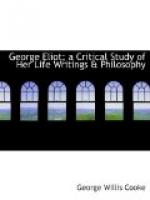There is less of distinct teaching in the Scenes of Clerical Life than in George Eliot’s later novels. Yet even in these earlier stories there is to be found many a clear indication of her thought. In “Amos Barton” she has especially set forth her sympathy with humble life. This fundamental canon of her art is presented more distinctly in this story, and dwelt upon more fully, than in any of her subsequent novels. It would be difficult to discover any special teaching in “Mr. Gilfil’s Love Story;” and this is perhaps the only production of George Eliot’s pen which has not some distinct object beyond the telling of the story itself. The religious motif is strong in Janet’s Repentance, and not to be mistaken by any attentive reader who now for the first time takes up the story. The value of religion as a reforming force is plainly inculcated, as well as that the main and only value of that force is altruistic. It presents a fine picture of the Evangelical movement and its work, though mainly on its humanitarian side. Its deeper spirit of devotion, its loftier religious ideal, its craving after a more intimate realization of the divine presence, is not portrayed. The real purport of the story is contained in its closing words, where the reader is told that the true memorial left behind him by Edgar Tryan is to be found in a life saved to all noble thing’s by his efforts.
It is Janet Dempster, rescued from self-despair, strengthened with divine hopes, and now looking back on years of purity and helpful labor. The man who has left such a memorial behind him must have been one whose heart beat with true compassion, and whose lips were moved by fervent faith.
These Scenes of Clerical Life surpass all George




